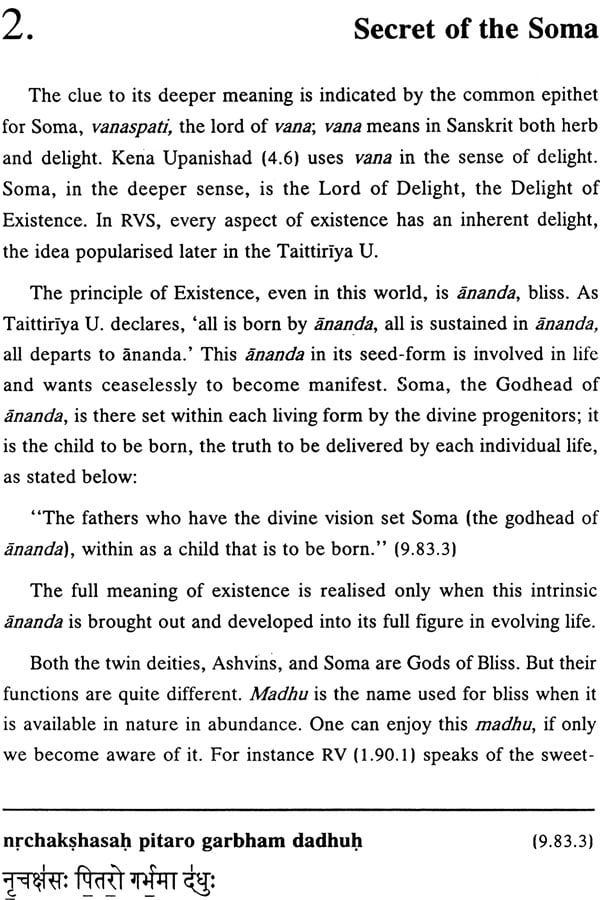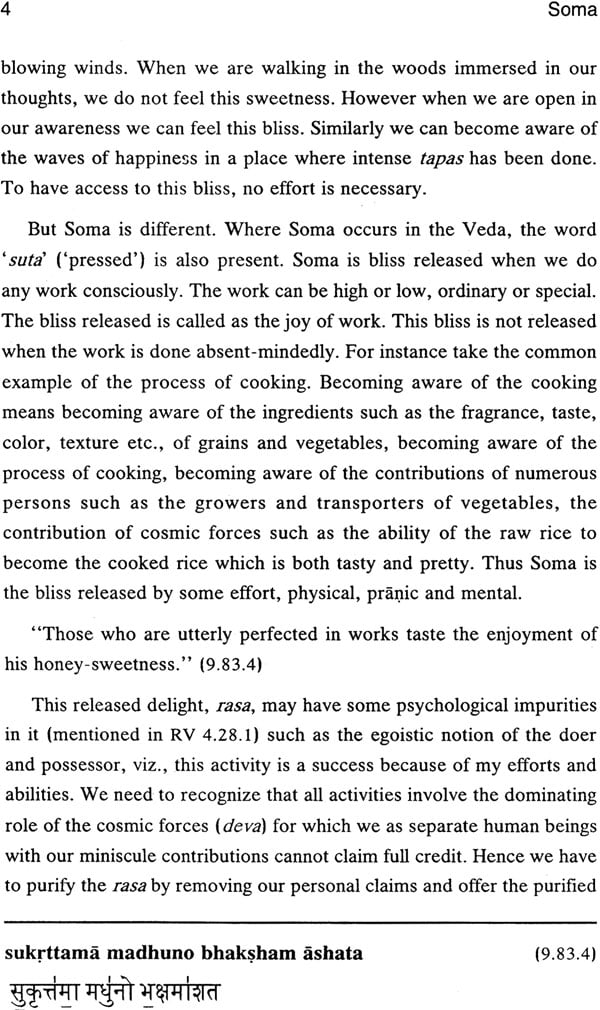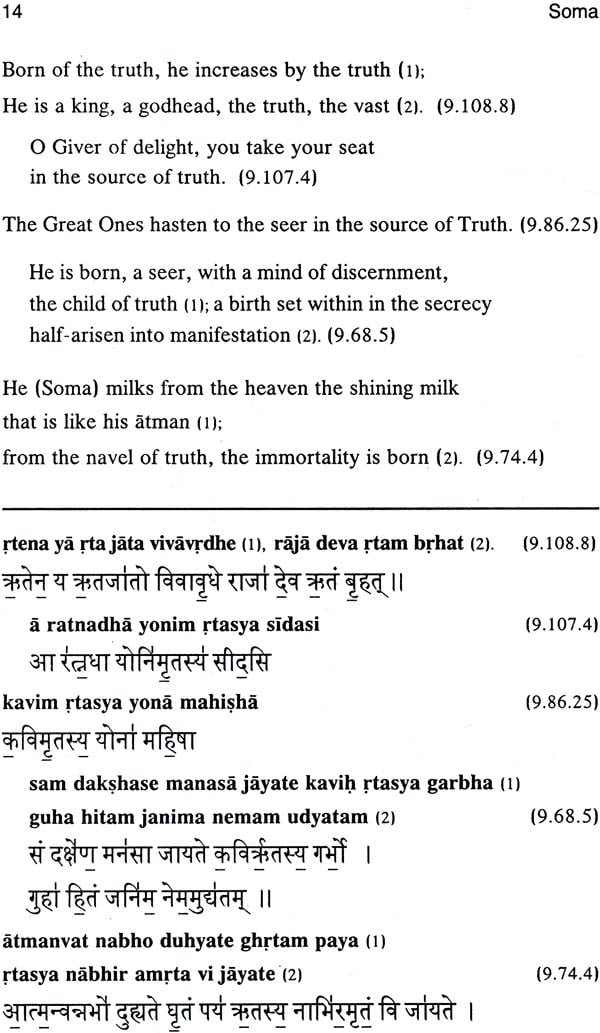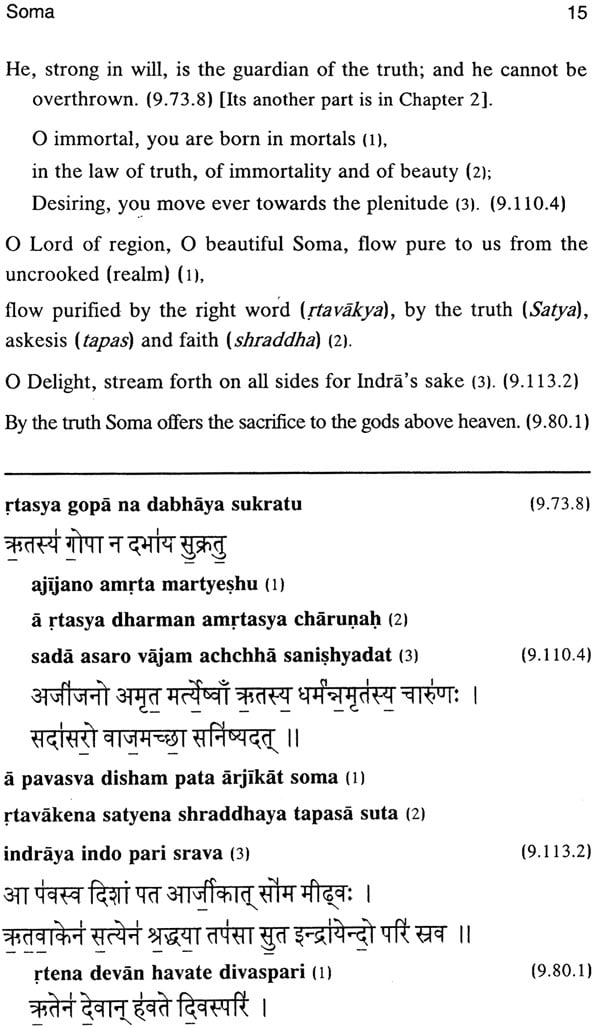
Soma (The Delight of Existence) (Sanskirt Text with Transliteration and English Translation)
Book Specification
| Item Code: | NAF104 |
| Author: | R. L. Kashyap |
| Publisher: | Sri Aurobindo Kapali Sastry Institute of Vedic Culture |
| Language: | Sanskrit Text with Transliteration and English Translation |
| Edition: | 2005 |
| Pages: | 44 |
| Cover: | Paperback |
| Other Details | 8.5 inch X 5.5 inch |
| Weight | 100 gm |
Book Description
Soma is the name of a deva. The devas are supraphysical beings without bodies and are endowed with consciousness, knowledge & power. A unique feature of Vedic devas is their camaraderie with the humans. They are eager to help human beings in their endeavour towards all-round perfection. Each deva is a storehouse of a particular type of psychological felicity.
Soma is the delight of existence. Delight encompasses everything. He is the master of existence .If we call him earnestly, he will rush to us. The mantras in this book will help us to know the Some deva and interact with him.
The Rig Veda Mantra Samhita has 1024 Suktas assigned to 10 mandalas. Each Sukta has several mantras or poetic metric verses, usually about ten on an average. The total number of mantras in RVS is 10,512. Every mantra is in Vedic Sanskrit. A mantra is not an intellectual composition. It was revealed to a rishi, usually through hearing; the rishi was in a state of deep concentration during the receiving of the revelation. Every mantra is one of several metres such as Gayatri, ushnik, etc. Every Sukta is dedicated either to one deity such as Agni, Soma, etc. or two or more. As mentioned earlier, each Sukta has several mantras and all of them describe the powers of the relevant deity and the prayers by the human devotee to that deity. Agni, Indra are not mere mythological or imaginary beings. Each deity represents a cosmic force with a well-defined function in the operation of Cosmos.
In some of the translations of the Rig Veda Samhita, the deities such as Agni, Indra etc. are represented as physical forces. For instance, Agni is regarded as the fire which burns everything; Soma is a creeper; Indra is the phenomenon by which rain comes out of the rain-bearing clouds etc. However such a summary description ignores all the descriptive epithets to that deity in the many mantras dedicated to that deity, such as 2000 mantras to Agni and 2500 mantras to Indra.
In the Hindu tradition, the Veda mantras in all the four Samhitas are regarded as wisdom. It is very difficult to locate any wisdom in most of the current translations of the Veda mantras.
It was Sri Aurobindo who revealed the hidden secrets in the Rig Veda. According to him, one must group together all the mantras dedicated to one deity, study all the epithets to that deity in them and thus understand the functions of the deity. Many of the epithets of the deities make no sense if we try to understand them in a purely physical manner. However when we expand our horizon and view them from the psychological point i.e., the point of view of mind and prana, the life-energy we clearly understand that every deity has one major psychological function, i.e., a function dealing with the activities of mind and life-energy. For instance, at a purely physical level, Agni is the fire in the hearth or altar; he is also the fire in the stomach which burns the food and digests it. At a psychological level, it is the power of will, the power which impels a person to do an activity. Similarly Indra is cosmic mind controlling all the operations of mind and life-energy. Soma is the joy in the performance of work.
Saksi has produced several small books of less than 100 pages, each book detailing the functions of one deity. The books dealing with Agni, the Divine Will, Sarasvati, the power of Inspiration, Indra, the Divine Mind are already available.
This book dealing with Soma, the Power of Delight in work is a new addition in this series. This book describes the powers of Soma accompanied by a hundred mantras of Rig Veda. For each mantra, we give the text in both the Devanagari and Roman script along with the English translation. To facilitate the reader who is not familiar with Sanskrit, the text of the mantra in both the Devanagari and the Roman script is shifted to the footnote.
Understanding the meaning of a mantra and the aspiration towards the deity helps the relevant cosmic power to manifest in each one of us and guide us from the within. The proper chanting is very helpful; but the meaning of the mantra should be in the mind during the oral chanting. Our earlier readers have complimented us on the inclusion of the Roman transliteration of the text of each mantra. The long Devanagri text with 10 or 15 syllables joined together can be a hindrance to its pronunciation even for a reader familiar with Hindi script. Recall that Hindi language has very little connection to the Sanskrit language or its texts.
Our earlier publications of this nature and size have attracted the attention of wider public. We hope that this book will also be received warmly by all Veda lovers.
| List of Abbreviations | iv | |
| Note to the Readers | v | |
| Note on Transliteration | vii | |
| 1 | Popular Misconceptions of Soma | 1 |
| 2 | Secret of the Soma | 3 |
| 3 | Soma as a Guide to Bliss: RV (1.91) | 8 |
| 4 | Soma and Truth (rta) | 12 |
| 5 | The Abode of Soma | 17 |
| 6 | Soma and Indra as Companions | 19 |
| 7 | Soma, Seers and Sun | 23 |
| 8 | Soma and the vivaha with Surya | 28 |
| 9 | Legend of Soma and the Falcon | 32 |
| 10 | Conclusions | 35 |









